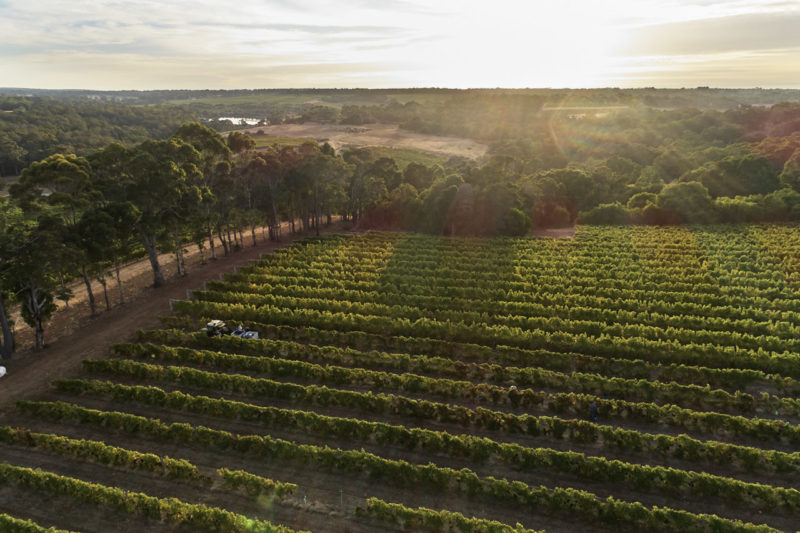
The Ribbon Vale Project
The Ribbon Vale Project – How Far Have We Come?
It’s almost 20 years to day that we began negotiations with our neighbour, John James, for the purchase of Ribbon Vale. There was a serendipitous meeting of needs. John, having established the vineyard in 1977, was looking for an exit strategy and we were looking to expand their wine production, through the purchase of a mature, high-quality vineyard.
Ribbon Vale suited the bill perfectly, sharing many key attributes with Moss Wood – similar Wilyabrup soils, cane pruning and of course, it was and remains unirrigated. The purchase was settled on 1st March, 2000 and we set about putting our own stamp on the property. What followed has been a fascinating adventure in grapegrowing and winemaking. We had to update the trellising to the new (at the time) Henry system. More challengingly, we had to learn how to make wine styles we hadn’t attempted before – Sauvignon Blanc and Merlot. The latter has required us to play the long game.
Merlot has been a challenge but one we have enjoyed far more than initially expected. This variety is the most widely planted in Bordeaux and very highly regarded there. Anyone lucky enough to taste Chateau Petrus or Chateau Cheval Blanc would surely understand why. Australian Merlot, with very few exceptions, is typically of only moderate quality and usually dismissed as soft, generic dry red. We admit to making that very criticism ourselves but once we were exposed to high-quality Merlot and how it is made, a whole new world has opened up. We have had to focus on the wines of Pomerol and St Emilion, looking in depth at their production techniques as well as the demanding task of tasting as many as we can. Very demanding indeed!
Another twist in the tale is, for Moss Wood we felt and still feel, the Cabernet Sauvignon style from that vineyard isn’t enhanced by the characteristics which Merlot would bring to the blend. So, with little or no experience we embarked on a very steep learning curve.
Amusingly, once we got to know Merlot, we discovered it shared several traits with Pinot Noir. Just like its Burgundian cousin, Merlot demands special attention in the vineyard and will only ripen well if the shoots are properly positioned, the canopy is allowing good sunlight penetration and the yield is moderate. This last point is crucial because Merlot will grow a monumental crop if allowed. The record under our ownership is 14.6 tonnes/hectare for the 2000 vintage – not bad for an unirrigated vineyard! Conditions in that year were exceptional and all varieties blitzed their average but we have trimmed it back since. The long-term yield stands at a still very respectable 7.87 t/ha. The quality risk is evident when we note that in the relatively warm year of 2000, the vines needed an extra 2 weeks to get all that fruit ripe and even then, sugar levels were only just where we wanted them and likewise colour depth. Many bad things can happen in 2 weeks, like rain damage and bird attack to name just two and hence the need for careful management.
By the year 2000 we had a long track record of making Cabernet Sauvignon at Moss Wood and this gave us some useful insights into how we might manage this variety at Ribbon Vale. However, every vineyard is different and we had to come to terms with what the new location required. For example, the clone planted at Ribbon Vale is SA126, which performs differently to the Houghton selection at Moss Wood. Even with improved trellising, we still spent several seasons understanding the flavour profile in the grapes and working out what levels of ripeness we should aim for. Exactly the same is true for Cabernet Franc.
Looking back over this period then, it could be summarised in the following way. We spent the first decade improving and analysing how the vineyard performed. As a result, we have spent the second decade seeing a gradual improvement in the quality of the wine style but the job is not yet finished. We have recently added Petit Verdot and Malbec to the Ribbon Vale vineyard and over the next few years we’ll be able to assess what role they may play in enhancing the Cabernet Sauvignon, in particular.
No doubt customers will have their own views on how the project has gone so far. For us, we are most proud of the quality of the Merlot. It’s not so much that we think it’s a better wine than the Cabernet Sauvignon but we are delighted with the overall improvement and are comfortable it is a serious wine, capable of bearing comparison with wines of this style from anywhere in the world.
The Ribbon Vale Cabernet Sauvignon has always been at a higher quality level but we are keen to see it recognised as one of the finest wines in this style from Margaret River. We have evolved it to the point where its primary fruit characters make it almost the complete wine. It has gone from requiring a significant blending component of Merlot, typically at least 20%, plus, of course, around 5-10% Cabernet Franc, to now just 1-2% each of these. If it’s OK with everyone else, we’ll give ourselves a pass mark so far.
